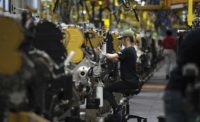With signs of rising activity in the U.S. and China construction markets, global equipment manufacturers reported strong sales in the second quarter of 2017, following a period of consolidation and reorganization.
In the wake of a restructuring effort driven by underperformance in its construction and mining sectors, Caterpillar Inc. posted strong results for the second quarter, outperforming analyst expectations. Overall, the company booked $11.3 billion in sales for a year-over-year increase of 9.6%. Cat’s construction division alone posted an 11.4% increase.
Cat CEO Jim Umpleby cites upticks in the Chinese construction market and the U.S. gas industry as particular highlights. “A number of our markets remain challenged,” he conceded during an earnings call on July 25, but he saw silver linings. “Mining and oil-related activities have come off recent lows, and we’re seeing improving demand for construction in most regions.”
Terex reported $95.4 million in profits for the second quarter, down from last year. The company is working through a consolidation following its abandoned merger with Konecranes last year, and half of its quarterly profits were from the sale of Konecranes shares. “We continue to implement our strategy to focus and simplify the company” says John L. # Garrison, Terex president and CEO. Equipment sales were up in key divisions, including cranes and aerial-work platforms.
Japan-based Komatsu Ltd. posted a 44% year-over-year increase in sales for the second quarter, but these numbers reflect the company’s recently completed acquisition of U.S.-based mining equipment maker Joy Global. But the company also cited growth in Asian markets, including China and Indonesia, as drivers.
European-based equipment manufacturers also saw improved sales carried by rising demand in China. Volvo Construction Equipment reported a 36% increase in year-over-year sales this past quarter. While there were positive increases in North America and Europe sales, Volvo CE’s sales in China rose 65% from last year, with increased deliveries of its SDLG wheel loaders and excavators.
French-based Manitou Group, which owns the U.S.-based Gehl and Mustang brands of compact equipment, saw year-over-year improvements in their mid-year assessment. Specializing in material-handling and compact equipment, Manitou cited healthy demand from the U.S. and European rental sectors as a main source of growth in its construction division.
Several manufacturers reported strong sales to the rental market, and rental firms’ own results appear to confirm this trend. United Rentals reported a 13.5% year-over-year increase in rental revenue for 2Q, with $141 million net income from total revenue of $1.597 billion. These results slip to a 6.6% increase in rental revenue when United Rental’s recently completed acquisition of NES Rentals is taken into account. “The broad demand we saw early this year continued throughout the second quarter as we entered our busy season,” says United Rentals CEO Michael Kneeland.
Herc Rentals saw an 8% year-over-year increase in rental revenue, but the firm reported a $27.6 million loss. It attributed this to an increase in interest payments on debt and the winding down of an IT initiative that was started before Herc spun off from Hertz Rentals last year. “Demand and pricing continued to improve year-over-year,” says Larry Silber, Herc president and CEO. “Upstream oil-and-gas markets appear to be stabilizing after more than two years of year-over-year declines.”


.jpg?height=200&t=1640294757&width=200)

Post a comment to this article
Report Abusive Comment